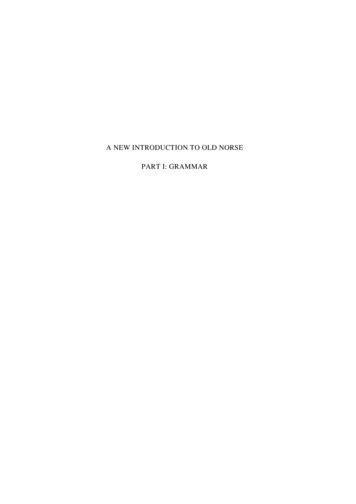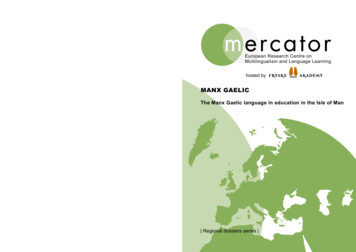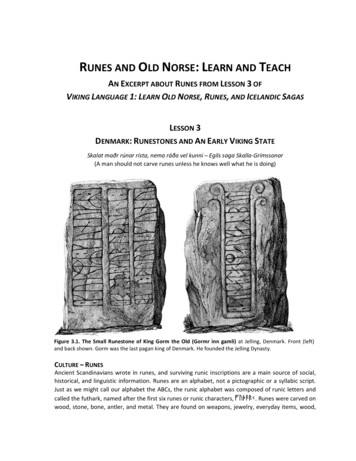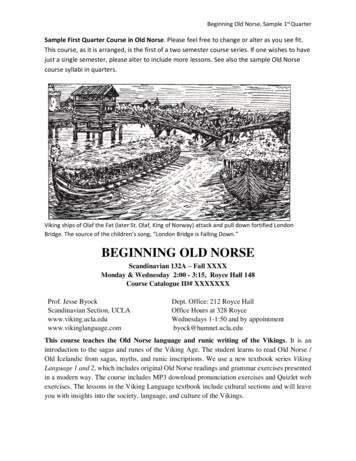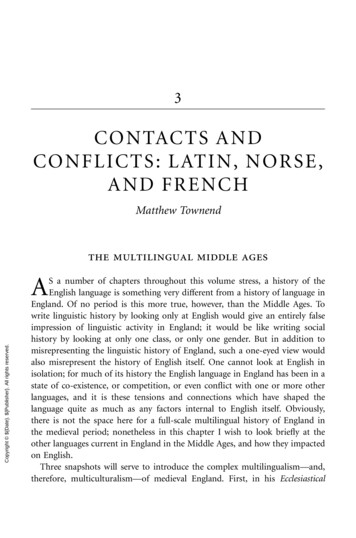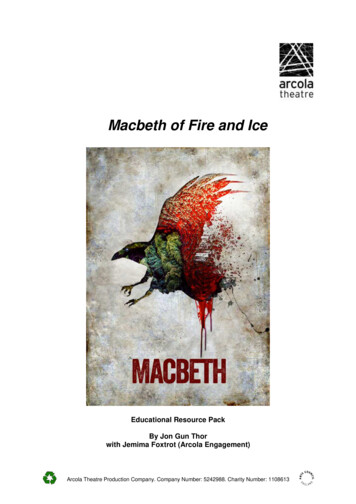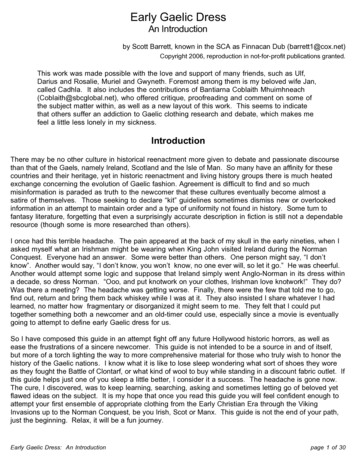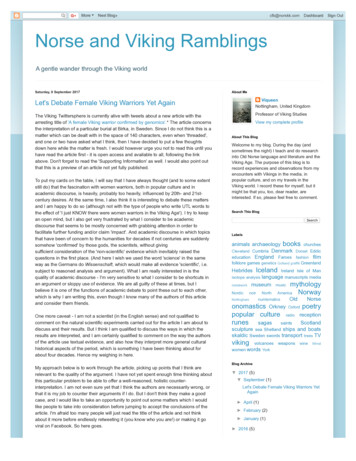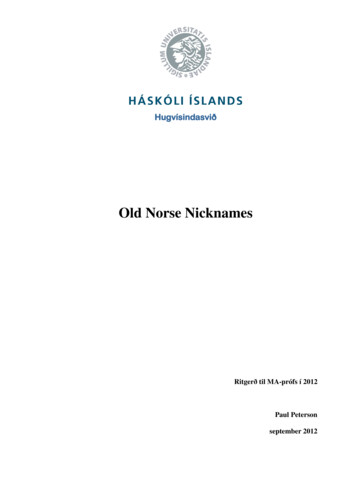
Transcription
HugvísindasviðOld Norse NicknamesRitgerð til MA-prófs í 2012Paul Petersonseptember 2012
Háskóli ÍslandsÍslensku- og menningardeildMedieval Icelandic StudiesOld Norse NicknamesRitgerð til MA-prófs í Íslensku- og menningardeildPaul PetersonKt.: 250284-3819Leiðbeinandi: Haraldur Bernharðssonseptember 2012
1Old Norse NicknamesPaul PetersonTable of ContentsAcknowledgements.2Introduction.3Chapter 1 ‒ Terminology, Collections, Prior Scholarship, and Future Research.6Terminology.6Dictionaries and Collections of Old Norse Nicknames.13Prior Scholarship.15Future Research.18Chapter 2 ‒ Origins, Meanings, and Features of Nicknames.19Skaldic Nicknames.19Nicknames Turned Personal Names.23Inheritable Family Nicknames.26Nicknames Referring to Private Parts.29The British Connection.31Geographic Origin of a Saga.35Chapter 3 ‒ Roles of Nicknames in the Literature.35Medieval Thoughts on Nicknames.36Terminological Patterns in Nickname Narratives.38Narratives Derived from Nicknames.41The Nicknames of Kings.43More Anecdotal Nickname Narratives.50Nickname Explanations in the Fornaldarsögur Norðurlanda.54Conclusion.57Bibliography.58Primary Sources.58Secondary Sources.61
2AcknowledgementsThis thesis owes a great debt to several entities and individuals without whom it couldnever have been written. It is with the greatest thanks to the financial support of theLeifur Eiríksson Scholarship Foundation that I have been able to spend a year studyingat the University of Iceland, where I have been able to pursue the Medieval IcelandicStudies (MIS) MA. Immense gratitude is likewise due to the support of institutionalsupport of Árnastofnun and the MIS program coordinators Torfi Tulinius and HaraldurBernharðsson, whose program has provided a uniquely wonderful background in allaspects of Old Norse scholarship. A special mention of thanks is due personally toHaraldur Bernharðsson, the advisor to this thesis and outstanding instructor of OldIcelandic. Also to be thanked is my Ph.D. advisor at the University of Minnesota,Anatoly Liberman, who originally suggested that I research the topic of Old Norsenicknames, from which spawned the idea to spend a year in Iceland researching themfor this thesis and my dissertation at home. Particular thanks in terms of scholarshipwhich thoroughly introduced this topic to me is due to Kendra Willson, whosedissertation (2007) on Modern Icelandic nicknames provided a great background to thisfield of study. In the same regard great homage is due to the brilliant article on saganickname narratives by Diana Whaley (1993), without whose thorough summary andframework of the most critical issues in this topic it would have been far more difficultto write this thesis.
3IntroductionOne of the richest sources of linguistic and cultural data past and present lies inthe field of onomastics, the study of names. This field owes its roots to traditionalphilology, which sought to explain the connections of language families by historicalcomparison of texts and attested linguistic data. This investigation is far from complete,and philology has itself branched out into numerous sub-fields, several of which couldnow be considered fields of their own (such as historical linguistics and materialphilology). Philology remains particularly strong in its ability to interpret the linguisticdata of languages both ancient and modern, as well as to provide a better understandingof literature from which the linguistic data were drawn.1 I would be remiss to claim thatonomastics, a sub-field primarily of linguistics and philology, has not seen its share ofattention since its academic inception in the 19th century, but much of the work remainsundone. After all, names play an integral part in language itself as a means to identifypersons and places and how they are connected to and differentiated from one another.Similarly, names can also be used as evidence of linguistic forms not attested otherwise,all the while enriching and preserving a language‟s stock of words.Nicknames, which occur in all cultures and across all time periods, play a vitalrole in understanding and highlighting identity. They also provide a unique window intoslang and popular culture less accessible through personal names alone. Their studyencompasses wide-ranging interdisciplinary scholarship, including onomastics (namestudies), historical linguistics, anthropology, history, and narratology. Old Norsenicknames themselves represent diverse forms of cultural expression from the lowerlevels of discourse, history, religion, and popular entertainment. They have leftremnants across Northern Europe in place names, runic inscriptions, and the names ofindividuals in the saga corpus.One simply cannot read a saga without encountering dozens of nicknamesthroughout the text, and recurring nicknames from saga to saga are common and thus1By philology, I do not mean material philology or new philology specifically, rather the traditionaldiscipline which seeks to use all available evidence to understand literature of a given period. Senses ofthe word vary from country to country and university to university, but the American definition tends tofollow more closely that of the Germans and Dutch, but not necessarily that of the Nordic countries(which, in general, tend to connect it more exclusively to manuscript studies and material philology).
4provide a hitherto unexplored tool for studying saga transmission and intertextuality inOld Icelandic literature ‒ topics which have received only mild attention in sagascholarship of the last century. The largest word bank of medieval Scandinaviannicknames lies in the realm of medieval Icelandic literature, and the overall approach ofmy thesis will be to describe the use of nicknames across the Icelandic literary corpus inlight of their Germanic origins, etymology, and role in the literature and its production. Iwill investigate the uses of nicknames in the family sagas within a cultural,anthropological, and narratological framework. I will seek to answer the questions:What role do nicknames play in expressing cultural sensitivities and ambiguities inmedieval Icelandic and Scandinavian society? How did they develop and become socommon especially during the medieval period? What role do they play in the literatureand what do they tell about the culture?The function of nicknames in the Middle Ages is peculiar, when kings could becalled Charles the Fat (Carolus Pinguis, 839-888 A.D.), Charles the Bald (CarolusCaluus, 823-877 A.D.), Louis the Stammerer (Ludovicus Balbus, Louis le Bègue, 846879), Pepin the Short (Pepinus Brevis, died 768), Ivailo Bardokva „radish, lettuce‟ orLakhanas „cabbage‟ (Bulgarian, died 1280), and the like, and when members of asociety (as is the case in medieval Iceland) would kill for a carelessly dropped word if itwas supposed to be detrimental to one's honor, yet tolerated the most demeaningnicknames. The nicknames of the Scandinavian royal houses (ancient andcontemporary) from Old Icelandic and, to a lesser degree, Old Norwegian literature willfigure prominently in this investigation, because of the high frequency of nicknamesamong the royals. It is primarily for this reason that I began developing this projectinvestigating nicknames, and I have since gathered a large body of literature ononomastics and nicknames themselves.A diachronic and frequently also an etymological analysis of Old Norsenicknames is necessary because they have never been compared with nicknames foundin other Old Germanic languages, for which a fairly large pool exists in runicinscriptions, Gothic (naturally, outside of Wulfila‟s translation of the Bible),Old/Middle High German, and Old/Middle English. Of particular interest for the topicof runic bynames, see Brylla (1993), Jacobsson (2010), and Peterson‟s articles anddictionaries (2002, 2002, 2004, and 2007, respectively). A collection of names in
5Vandalic and East Gothic is provided by two works by Wrede (1886 and 1891,respectively). On the topic of Middle High German nicknames, see Socin‟sMittelhochdeutsches Namenbuch (1903), and particularly chapter 19 which discussesÜbernamen (407-462), and especially the Anmerkungen (457-462), which deal brieflywith the history of nicknames in Old Germanic societies. For a fantastic collection ofOld English bynames, see Tengvik (1938), and for two collections of Middle Englishnicknames, see Seltén (1969 and 1975, respectively). The spread of Norse culture acrossEurope left its traces in areas of settlement, particular in the form of place names butalso personal names. Several scholarly works in this regard are worth noting: O. Rygh‟scollection of Old Norse names in Norwegian place names (1901), des Gautries‟collection of Norse names in Normandy (1954), and, perhaps most appropriate to thistopic, the article by Halvorsen (1975) on place names used as bynames in medievalNorway and Iceland. Several works on personal names in the British Isles have, almostas an unintended result, large collections of bynames, including: Björkman‟s collectionof Norse names in England (1910), Fellows-Jensen‟s book (1968) analyzing the stock ofpersonal names in Lincolnshire and Yorkshire (the bulk of which derive ultimately frombynames, which in large part are nicknames), where a large number of these names (ofall classes) are reconstructed from place-names, and lastly, another article by FellowsJensen (1995) on the personal and place name evidence left by the Vikings in Englandis worthy of mention.The sheer number and frequency of Old Norse nicknames by comparison toother medieval cultures and even other Old Germanic societies is, however, uniquelyrich. Janzén (1947, 242) notes of the high volume of Old Norse bynames, “Binamnenkom i Norden i bruk i en omfattning som är ojämförligt större än i andra delar av dengermanska världen.”2 The primary focus of this investigation will thus be limited tonicknames in the Icelandic literary corpus, but a diachronic analysis of earlierattestations of nicknames in other old Germanic languages and runic inscriptions fromScandinavia is necessary in further research to describe the developments of nicknamesprior to the arrival of settlers in Iceland in the late 9th century. It should also be admittedthat I will only make limited references in this study to the smaller body of nicknames2“Bynames came into use in the Nordic world to an extent which is incomparably larger than in otherparts of the Germanic world.” This translation and all others are mine, unless specifically noted.
6that occur in runic inscriptions, Old Swedish, and Old Danish if for no other reason thana relative lack of richness and variety in comparison to large body of nicknames inmedieval West Norse sources. From there, a literary and linguistic analysis ofnicknames will be more fruitful in texts from the 13th century onward concerning thefamilies of Icelanders, Norwegians, Swedes, Danes, and others who make their way intothe literature. To date there has been no comprehensive analysis of nickname originsand development or research into their prominent appearances in the literature. Myoverall focus in this thesis is therefore on the development of nicknames in the sagas inorder to highlight as many issues relevant to onomastics, narratology, etymology, and,more generally, medieval Nordic society and culture.Regarding the organization of this investigation, I have divided the content intoroughly three chapters with several subchapters in each, followed by a short conclusion.Chapter 1 discusses the terminology for describing nicknames in the scholarly tradition,the scholarly material from which my analysis is based, as well as a brief proposal forfurther research on nicknames. Chapter 2 uses primarily an anthropological or culturalapproach around several miscellaneous topics in order to highlight some of the manyfeatures encountered in the study of nicknames. Chapter 3 approaches the literary sideof nicknames, discussing the many uses of nicknames in the composition of sagas andthe roles they can play in the literature. The conclusion is brief and only intended tosummarize the main themes covered in this investigation.Chapter 1 ‒ Nicknames: Terminology, Collections, and Prior ScholarshipTerminologyThe terminology used to describe nicknames varies among the Scandinavian languages(including Icelandic), German, and English. Particularly confusing in English is wherethe all inclusive term “nickname” is often used by both specialists and non-specialistsalike to describe hypocoristic pet names which, to my mind, do not accurately representnicknames but instead are one type of byname (ex. Johnny, Bob, Teddy, etc.). The sameissue of loose terminology occurs practically everywhere across linguistic boundaries,in part due to conflation of the separate traditions of giving nicknames and giving pet
7names or bynames. Hence the well-known and common Scandinavian expression (herein Swedish): kärt barn har många namn „a dear child has many names‟. Yet themedieval evidence, as best as we can tell, made a stronger distinction betweennicknames and hypocorisms (the latter being far less represented in medievalScandinavia, though perhaps more common in other Old Germanic societies). One ofthese traditions consisted of the giving a shortened byname, that is truncated, familiarpet forms (such as Óli for Óláfr and Tósti for Þorsteinn), many of which throughfrequent use became personal names proper, and the other of giving a secondary nameor agnomen to supplement a given personal name as an addition to it. It is the latter thatI intend to give a full description throughout this work.Although using the term agnomen (pl. agnomina) is equally problematic asusing the term nickname, in part because the historical developments of namingtraditions and the uses of agnomina in the Roman world, it corresponds best to themeaning of nickname as I will use it throughout this study. Originally the Latin termcognomen (not the modern English borrowing which does indeed mean more generally“nickname”) would have been the most appropriate to describe nicknames, for thesewere originally Roman nicknames, but as these became inherited as enhancements toclan names by identifying sub-families within these clans, the usage of this term fornicknames became no longer apt. Thus, the ever-descriptive Romans developed theterm agnomen for a nickname which describes an individual after the term cognomencould no longer be accurately applied. Several Roman writers themselves described theintricate naming customs of Roman society, among them Pseudo-Probus who wrote inhis 4th century Instituta artium (in the section about nouns entitled de nomine) about thefull name of the Punic War hero Publius Cornelius Scipio Africanus:propria hominum nomina in quattuor species dividuntur, praenomen nomen cognomenagnomen: praenomen, ut puta Publius, nomen Cornelius, cognomen Scipio, agnomenAfricanus.3[People‟s personal names are divided into four types: praenomen, nomen, cognomen,agnomen; praenomen, for example, Publius, nomen Cornelius, cognomen Scipio,agnomen Africanus.]3In Grammatici latini, Vol. IV (Keil 1864, 119, 31-33).
8In this case, the name of this man is divided into four categories: the first, Publius, beingthe only equivalent of a given name; the second, Cornelius, is a clan name; the third,Scipio, was originally a nickname meaning „staff, scepter‟ (as a sign of authority), butlost its nickname quality when it became inherited as a means to identify a sub-branchwithin the larger Cornelius clan; the last, Africanus, is the only equivalent of anickname.More pertinent to the discussion at hand, the agnomen, which is truly the closesttechnical term for a descriptive nickname, is defined by the 4th century African-Romanwriter Marius Victorinus in his commentary Explanationum in rhetoricam on Cicero‟sDe inventione:Iam agnomen extrinsecus venit, et venit tribus modis, aut ex animo aut ex corpore autex fortuna: ex animo, sicut Superbus et Pius, ex corpore, sicut Crassus et Pulcher, exfortuna, sicut Africanus et Creticus.4[The agnomen comes from without, and comes in three ways, either from character orfrom the body or from circumstance: from character, so Superbus („the arrogant‟) andPius („the loyal‟), from the body, so Crassus („the fat‟) and Pulcher („the beautiful‟),from achievements, so Africanus („the victorious in Africa‟) and Creticus („thevictorious on Crete‟).]Considering that the bulk of Old Norse nicknames fit into these three defined categoriesof the Roman agnomina, this term may be used accurately to describe these types ofnicknames. To avoid further confusion, however, I will stick with the less well-definedterm “nickname” to describe what could also be appropriately called agnomina. Note,however, that the Roman agnomina with a geographic title (Africanus and Creticus),which appear at first glance to be topographical or ethnic, are in fact nothing of the sort.Such geographic agnomina are given in recognition of an individual‟s accomplishmentsin warfare against these regions, not their geographic origin or area of inhabitation(which, by contrast, are rather common types in Old Norse).Returning to the North, in numerous cases this attached name, most often in theform of a weak adjective, could also function as a replacement for the given name (butcould not actually be the personal name), showing that these nicknames were really justone of several components of an individual‟s given name (not unlike the situation in4In Rhetores latini minores (Halm 1863, 215, ll. 2-5).
9Rome, but certainly less sophisticated in the North). One must also bear in mind thatproper surnames in the medieval period were extremely rare in the North, andnicknames were often the closest equivalent in that they were often permanentlyattached to and indistinguishable from a personal name. In an attempt to avoidconfusion among the numerous onomastic terms mentioned in several languages andhistorical traditions, I will use primarily the Icelandic terminology and correspondingEnglish terms (where available) which best reflect these nuances as they come up in thediscussion.The vocabulary that surrounds the classification of nicknames is enormous andvaries from language to language. Therefore, defining clear-cut examples within suchclassifications is extremely difficult. The English word nickname itself implies aconnection with a secondary name, or more precisely, a name which is added to anindividual‟s personal name. The term developed from ME ekename, whose firstcomponent eke- „increase‟ ( OE ēaca „increase‟) developed into nickname ( anekename) by metanalysis. OE ēaca developed from the root which is found in theGermanic verb *aukanan „increase, augment‟, with cognates across Germanic and IndoEuropean, for example ON auka „to increase‟, Lat. augere „to enlarge, increase‟, andLith. áugu, áugti „to grow‟ (Orel 2003, 29).The terminology used in Old Icelandic is, as befits a study of primarily OldIcelandic literature, is still the best for the purposes of this study, so when possible I willuse these terms. Several terms are used, almost interchangeably, for nicknames. Themost common term for nickname in Old Norse is viðrnefni (Mod. Icel. viðurnefni viðurnafn, Swed. tillnamn [less commonly vedernamn]), which signifies in the mostobvious manner an “added name.” Lindquist (1947, 14) proposed using the archaic, butperhaps more appropriate technical Swedish term vedernamn for nicknames which areused: “.antingen för att skilja honom från andra personer med samma namn eller för atthedra eller nedsätta honom;”5 his attempt to restore this word even in academicliterature has been almost entirely unsuccessful. Also in Swedish and Scandinavianscholarship there are the frequently used terms tillnamn „additional name‟ (Dan./Norw.tilnavn [occasionally NNorw. tilnamn]), which is the most suitable to describe5“.either to distinguise him from other people with the same name or to praise or insult him.”
10nicknames in these languages, and the closest corresponding term to match up withviðrnefni. Binamn „secondary name‟ is in several regards is more problematic, not leastbecause it includes titles, occupational and otherwise, and secondary names ofgeographical origin. There is additionally the frequently used Old Norse nickname termkenningarnafn, meaning something like “an alternate name by which an individual isknown” (cf. the discussion of the nickname of Haraldr hárfagri [„Fair Hair‟] below]).These terms, viðrnefni and kenningarnafn, are by their nature neutral.The cognate of nickname in Old Icelandic called auknefni „increased name,nickname‟ (cf. Swed. öknamn, Dan. øgenavn, and North Ger. Ökelname, all with thesame meaning) can either be neutral or, in many cases, condescending. The term inIcelandic (and the Scandinavian languages) seems to have developed from its simplemeaning of an “increased, additional name” into having a subtly negative connotation, ifonly as a result of the high frequency of abusive auknefni (cf. the discussion below). Asa near parallel term to auknefni, there is aukanafn with a similar, but not identicalmeaning „extra title, byname‟ (cf. also the verbal form auka nafn „to increase a name,add a title‟). The terms auknefni and aukanafn are not synonymous, but the two areclearly related and occur already in the 13th century. It is possible that aukanafn wascoined as means to differentiate bynames that are titles from those which are nickname,but there is little evidence to advance this notion.Auknefni, perhaps by their very nature as nicknames, are so frequently negativethat Cleasby/Vigfusson (1874, 34) mention the term as having two separate senses ofthe meaning „eke-name, nickname‟: first, a defamatory name, punishable by lesseroutlawry; second, in a less strong sense (that is, as a regular nickname). Dividing themeaning into two senses is misleading, however, because the basis for a negativeconnotation is purely contextual. Even so, this opinion is not entirely unfoundedconsidering that a large percentage of auknefni are indeed derogatory. There is in fact astipulation in the large section covering battle and homicide called vígslóði („battleslot‟) in Grágás (as found in Staðarhólsbók, AM 334 fol., from 1260-1281) againstgiving auknefni if they are intended as derogatory:
11Ef maðr gefr manne nafn annat en hann eigi. oc varðar þat fiör Baugs Garð ef hiN villreiðaz við. sva er oc ef maðr reiðir avknefni til haðungar honom oc varðar þat fiör6Baugs Garð oc scal þat hvartueGia søkia við xii. quið.[If someone gives a person a different name than the one he already has, it is punishableby lesser outlawry (three years exile) if the other one is angered by it. As such it is alsothe case if someone spreads around a nickname to degrade him, it is punishable bylesser outlawry, and it shall in both cases be decided by the verdict of twelve men.]This stipulation reflects the social power of “calling people names” (precisely as themodern expression still maintains) and using nicknames as terms of abuse, and it is littleshock that such a harsh penalty could be awarded when honor and reputation were onthe line.Not particularly different in meaning and use, but used only in the modernperiod, is the term uppnefni meaning „a dubbed name, nickname‟ (cf. also nefna upp „torename‟). This term is, however, more commonly applied to nicknames given in teasingthan the other nickname terms. Guðrún Kvaran mentions this distinction in her forewordto Bragi Jósepsson‟s book (2004) on modern Icelandic nicknames in Stykkishólmur:Með orðinu viðurnafni er átt við viðbót við eiginlegt nafn karls eða konu. Annað heiti áþví sama er auknefni. Oft getur verið skammt á milli viðurnefnis og uppnefnis. Uppnefnieru þó oftar meira niðrandi en viðurnefnin og gefin af stríðni eða vegna einhvers atviks,spaugilegs eða neyðarlegs.7[With the word viðurnafn it is meant an addition to the personal name of a man orwoman. Another name for the same thing is auknefni. Often there can be littledifference between a viðurnefni and an uppnefni. Uppnefni are, however, more oftenmore derogatory than the viðurnefni and given in teasing or because of some event,funny or embarrassing.]Even with the linguistic purism for which Icelandic is famous, it is not possible to saywithout a doubt that the modern distinctions, themselves loosely defined, can beperfectly applied to the more fluid situation of terminological distinctions in OldIcelandic. These guidelines, however, are ones which can be found in the terminologicaldistinctions used by the medieval sources themselves (except uppnefni, which does notappear in Old Icelandic). While it is certainly a huge challenge to apply definitive6Diplomatic text from Grágás efter det Arnamagnæanske Haandskrift Nr. 334 fol., Staðarhólsbók(Vilhjálmur Finsen 1879, 391-392).7From the introduction to Uppnefni og önnur auknefni (Bragi Jósepsson 2004, 7).
12terminology to the study of nicknames, the most appropriate terms for describingseveral of the main types of nicknames are indeed those found in Old Norse sourcesthemselves.The number of nicknames in the Old Icelandic corpus is enormous, and it is forthis reason that I have chosen to neglect a proper study of pet names and hypocoristicforms, as well as titles. In Icelandic the terms for a hypocoristic name are gælunafn „petname‟, corresponding to Dan. kælenavn „pet name‟ and Norw. kjælenavn, and stuttnefni„short name‟; both Icelandic terms correspond in meaning to Swed. smeknamn „petname, sobriquet‟ as well as Germ. Kosename „pet name‟. I will instead refer the readerto those studies made in hypocoristic and short Icelandic names by Stark (1868), FinnurJónsson (1920), Guðmundur Finnbogason (1926), Hannes J. Magnússon (1956), Hale(1981), Villarsen Meldgaard (1983), Höskuldur Þráinsson (1997-1998), AðalheiðurÞorsteinsdóttir (1998), Helgi Skúli Kjartansson (2000), Bragi Jósepsson (2004), andWillson (2008). I will neglect the study of bynames which represent medieval familynames and occupational bynames (that is, titles) such as konungr, jarl, skáld, smiðr, andthe like in so much as they do not concern nicknames directly, unless there is somedistinct reason to discuss occupation bynames. If, however, there is an additional epithetattached to such bynames (for example, Hallfreðr vandræðaskáld „troublesome poet‟), Iwill treat them as nicknames. Likewise, bynames which merely reflect geographicalorigin will not be treated as nicknames unless they suggest that this component of aname contained an epithet as more precise identification of an individual.I will defer the topic of titles and family names to Birger Sundqvist‟sdissertation (1957) on Swedish bynames of German and Dutch origin, the articles inBinamn och släktnamn (NORNA-rapporter 8, Thorsten Andersson, ed. 1975), a studyby Svavar Sigmundsson (2004) on Icelandic middle and family names, and a chapter onthe development of personal names in late medieval Scandinavia by Wiktorsson (2005,1171-1187, covering family names in subsection 2.9 [1177-79]). Countless literature onsurnames exists and collections of various European surnames are many, but for thesame reason noted above for titles, they will be left out of this study. These topics wouldbe of primary interest to a specialist in Northern European surnames and family names,since this material deals with the late medieval/early modern period, when bynamesbegan to become permanently attached to individual members of a particular family.
13Dictionaries and Collections of Old Norse NicknamesDictionaries and collections of medieval personal names and bynames from everyScandinavian country exist. The standard reference work for medieval Icelandic andNorwegian names is still E.H. Lind‟s Norsk-isländska dopnamn ock fingerade namnfrån medeltiden, samlade och utgivna med förklaringar. (1905-1915, supplement 1931).Medieval Swedish names have two standard reference works: Svenska personnamn frånmedeltiden (M. Lundgren, E.
with the history of nicknames in Old Germanic societies. For a fantastic collection of Old English bynames, see Tengvik (1938), and for two collections of Middle English nicknames, see Seltén (1969 and 1975, respectively). The spread of Norse culture across Europe left its traces in areas
